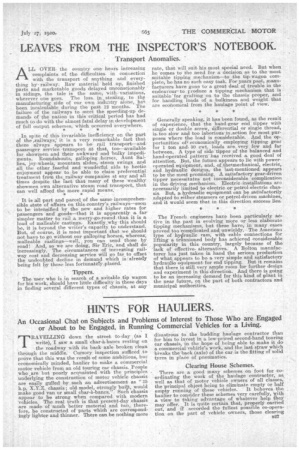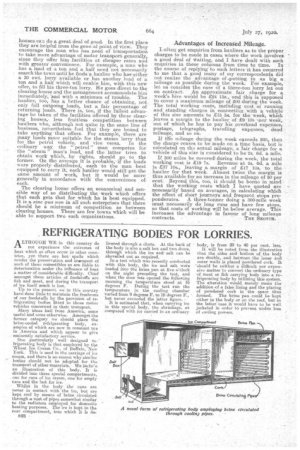HINTS FOR HAULIERS.
Page 25

Page 26

If you've noticed an error in this article please click here to report it so we can fix it.
An Occasional Chat on Subjects and Problems of Interest to Those Who are Engaged or About to be Engaged, in Running Commercial Vehicles for a Living.
TRAVELLING down the street to-day ,(as I write), I saw a small char-à-banes resting on the roadway with its back axle broken clean through the middle. Cursory inspection sufficed to prove that this was the result of some ambitious, but economically minded, haulier to make a commercial motor vehicle from an old touring car chassis. People who are but poorly acquainted with the principles -underlying the construction of motor vehicle chassis are easily gulled by such an advertisement as "35 h.p. X.Y.Z. chassis ; old model, strongly built, would make good van or small char-a-bancs.” Such chassis appear to be strong when compared with modern vehicles. The real truth is that present-day chassis are made of much better material and tan, therefore, be constructed of parts which are correspondingly lighter and thinner. There can be nothing more disastrous to the budding haulage contractor than for him to invest in a low-priced second-hand touring car chassis, in the hope of being able to make it do a commercial vehicle's work, and the last straw which breaks the-back (axle) of the car is the fitting of solid tyres in place of pneumatics.
Clearing House Schemes.
There are a good many schemes on foot for coordinating the work of the haulage contractor, as, well as that of motor vehicle owners of all classes, the principal object being to eliminate empty or half empty running of these vehicles. It behoves the haulier to consider these schemes very carefully, with a view to taking advantage of whatever help ihey may offer. It is quite certain that, properly carried out, and IT accorded the fullest possible co-operation on the part of vehicle owners, those clearing
houses can do a great deal of good. In the first place they are helpful trora the gene,a1 point of view. They encourage the man who has need of transportation to take more advantage of motor transport generally, since they offer him -facilities at cheaper rates and with greater convenience. For example, a. man who has a load of a, ton and a half need not necessarily search the town until he finds'a, haulier who has-either a 30 cwt. lorry available or has another load of a ton and a, half which will enable him, with this new oiler, to fill his three-ton lorry. Ile goes direct to the clearing house and the management accommodate him immediately, 'and with a minimum of trouble. The haulier, too, has a Letter chance of obtaining, not only full outgoing loads, but a fair percentage of returning loads. -There is, too, if the fullest advantage be taken of the facilities offered by these clearing houses,less fruitless competition between hauliers who, although not quite in the same line of business, nevertheless feel that they are bound to take anything that .offers. For example, there are many loads more suitable for the steam 'lorry than for the petiol vehicle, and vice versa. In the ordinary way_ the "petrol" man competes for the "steam" man's load, and the latter tries to obtain work which, by rights, should go to the former. On the average it is probable,' if the loads were properly distributed, each to the man best equipped to carry it, each haulier would still get the same amount of work, but it would be more generally in accordance With the convenience of each.
The clearing house offers an economical and sensible way of so distributing the work which offers that each gets that for which he is best equipped. It is a sine qua non in all such enterprises that there should be a minimum of competition as between clearing houses. There are few towns which will be able to support two such organizations.
Advantages of Increased Mileage.
I often get enquiries from hauliers as to the proper charges to be made in cases where the work involves a good dead of waiting, and I have dealt with such enquiries in these columns from time to time. In the course of replying to such letters it has occurred to me that a, good many of my correspondents did not realize the advantage of-putting in as big a mileage as possible during the week. For example, let us -consider the case of a three-ton lorry let out on contract. An approximate fair charge for a week's hire woUld be 224 15s.' and this is supposed to cover a maximum mileage of 200 during the week. The total working costs, including cost of running and standing charges in connection with a vehicle of this size amounts to 215 5s. for the week, which leaves a margin to the haulier of 19-10s. 'Der Week, out of which he has to pay his overhead expenses, postage, telegraphs, travelling expenses, dead mileage, and so on.
If tee mileage during the week exceeds 200, then the charge ceases to be made on a time basis, but is calculated on the actual mileage, a lair charge for a vehicle Of this size is considered to be 2s. 6d. a mile.
If 300 miles be covered', during the week, the total working cost is 219 7s. Revenue at 2s. ad, a mile is 237 10s., leaving a margin of 217 10s. to the haulier for that week. Almost twice the margin is thus available for an increase in the mileage of 50 per cent. Beyond this, too, it should be borne in mind that the working costs which I have quoted are necessarily' based on averages, in calculating which the effect of short journeys and frequent, stops preponderates. A three-tonner doing a 300-mile week must necessarily do long runs and have few stops, so that costs of working will be below average. This increases the advantage in favour of long mileage contracts. THE SKOTCH.




























